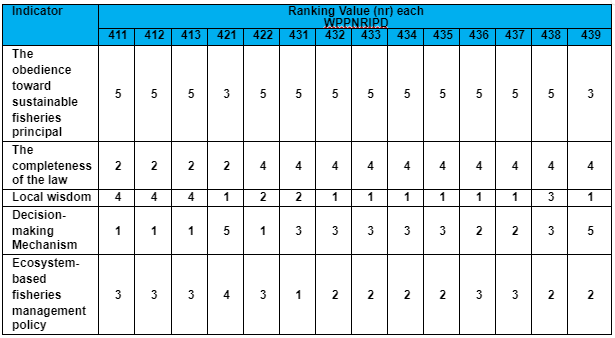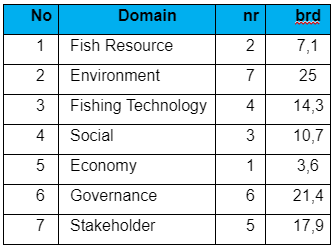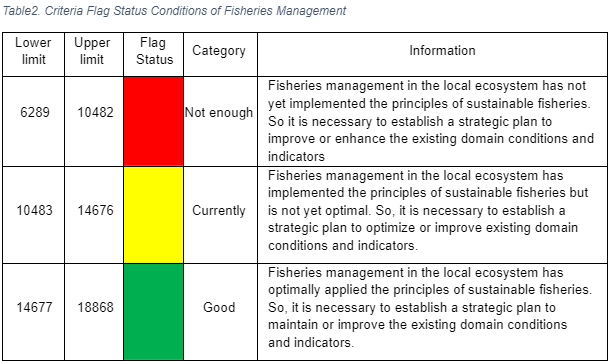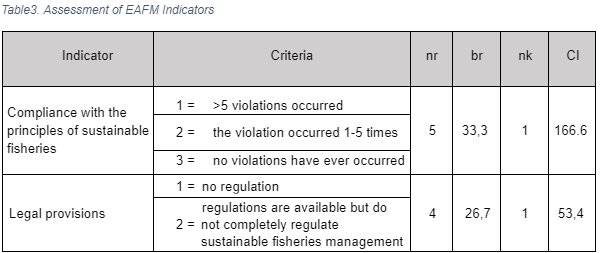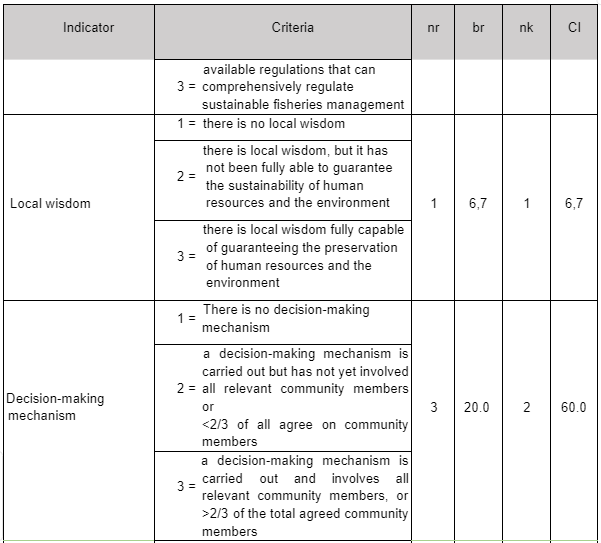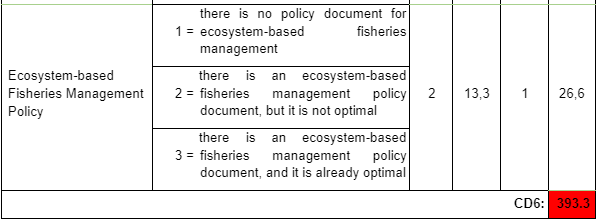CHAPTER III. EAFM Indicator Scoring Technique
1. Data collection technique
In assessing EAFM indicators in the Governance domain, primary data obtained through direct field observations and secondary data from available references can be used. Interviews were conducted after determining the selected respondents from the sampling results. It was carried out by face-to-face debriefing utilizing a guide or questionnaire to obtain information according to the purpose of this study. The characteristics of direct interviews are as follows.
-
The interviewer and respondent do not know each other;
-
The interviewer asked, then the respondent answered;
-
The interviewer is neutral, does not direct the respondent; and
-
The questions asked to follow the guideline of the questionnaire.
The sampling was carried out using the stratified random sampling method, in which the interview respondents were determined in stages. This sampling technique pays attention to each population element from each group that does not overlap (homogeneous elements) and must have the same opportunity. Strata sampling can use administrative limits, experience levels, and fishermen's productivity. The allocation of the number of samples from each level is sought using the principle of proportional allocation.
The data collection techniques for each indicator are described as follows:
a. The Compliance Indicator with the Principles of Sustainable Fisheries
Data/information on indicators of compliance with the principles of sustainable fisheries can be obtained through the following:
-
Direct observation of fishing communities to identify the level of violations in fisheries management practices in an inland water ecosystem;
-
Report on the results of monitoring/supervision of capture fisheries from the related work unit;
-
Reports on the research results /study from related research institutions, Higher Education institutions, or academics; and/or
-
The results of interviews with other competent respondents.
The steps for giving criterion values to indicators of compliance with the principles of sustainable fisheries are:
-
Collecting data/information on all fisheries management rules in an inland waters ecosystem, both formal and informal regulations or based on local wisdom;
-
Identification of types and number of violations against fisheries management rules in an inland waters ecosystem in the last 5 (five) years; and
-
Rate the criterion (nk) indicator of compliance with the principles of sustainable fisheries with the following scoring criteria:
-
nk = 1, if there are a violation > 5 times
-
nk = 2, if there is a violation of 1-5 times
-
nk = 3, if there has never been a violation
Some of the stakeholders who can be used as respondents in evaluating indicators of compliance with the principles of sustainable fisheries include:
-
Staff in the Regional Work Unit in the province/regency/city, which handles governmental sub-affairs in the field of capture fisheries;
-
Staff in the related work unit;
-
Academics/researchers from higher education institutions/other research institutions;
-
Public figure;
-
fishery extension; And
-
Fisherman.
2. Indicator of Completeness of Legal Rules
Data on indicators of the completeness of legal rules can be obtained through the following:
-
Direct observation to the relevant work unit office to identify regulations that exist or are being made; and/or
-
The results of interviews with other respondents were competent.
The steps for assigning a criterion value to the indicator of the completeness of the rule of law method are:
-
Collecting data on all regulations that exist or are being made;
-
Identification of completeness or scope of regulation in managing sustainable fisheries management; and
-
Give the criterion value (nk) the indicator of the completeness of the rule of law according to the identification results, with the following value criteria:
-
nk = 1, if there is no regulation yet
-
nk = 2, if regulations are available but have not completely regulated sustainable fisheries management
-
nk = 3, if there is a comprehensive regulation that can regulate sustainable fisheries management
Several stakeholders who can be used as respondents in assessing indicators of the completeness of the rule of law include:
-
Staff in the Regional Work Unit in the province/regency/city, which handles governmental sub-affairs in the field of capture fisheries;
-
Staff in the related work unit;
-
Public figure;
-
Fishery extension; and
-
Fisherman.
3.Local Wisdom Indicator
Local wisdom indicator data can be obtained through the following:
-
Direct observation of fishing communities to identify local wisdom;
-
Report on the results of monitoring/supervision of capture fisheries from the
-
Reports on the results of research/study from related research institutions, Higher Education institutions, or academics; and/or
-
Results of interviews with other competent respondents
The steps for giving a criterion value to the local wisdom indicator are:
-
Collecting data on all local wisdom in an inland waters ecosystem;
-
Identification of local wisdom that can guarantee the sustainability of SDI and its environment; and
-
Give the value of the criteria (nk) for indicators of local wisdom according to the identification results with the following value criteria:
-
nk = 1, if there is no local wisdom
-
nk = 2, if there is local wisdom, but it is not fully capable of guaranteeing the preservation of natural resources and the environment
-
nk = 3 if there is local wisdom and is fully capable of guaranteeing the preservation of human resources and the environment
Some of the stakeholders who can be used as respondents in evaluating indicators of local wisdom include:
-
Staff in the Regional Work Unit in the province/regency/city, which handles governmental sub-affairs in the field of capture fisheries;
-
Staff in the related work unit;
-
Public figure;
-
Fishery extension; and
-
Fisherman.
4.Decision-Making Mechanism Indicator
Decision-making mechanism indicator data can be obtained through the following:
-
Direct observation of fishing communities to identify decision-making mechanisms for the utilization of SDI in an area ecosystem inland waters;
-
Reports on the results of research/study from related research institutions, Higher Education institutions, or academics; and/or
-
Results of interviews with other competent respondents.
The steps for assigning a criterion value to the decision-making mechanism indicator are:
-
Collecting the number of fishing community members in an inland waters ecosystem;
-
Identification of decision-making mechanisms used by a fishing community in an inland waters ecosystem in solving problems or making joint decisions; And
-
Give the criterion value (nk) of the decision-making mechanism indicator according to the identification results in number 2, with the following value criteria:
-
nk = 1 if there is no local wisdom
-
nk = 2 if there is local wisdom, but it is not fully capable
-
nk = 3 if there is local wisdom and is fully capable of guaranteeing the preservation of human resources and the environment
Some of the stakeholders who can be used as respondents in assessing indicators of permitted fishing gear include:
-
Academics/researchers from higher education institutions/other research institutions;
-
Public figure;
-
fishery extension; And
-
Fisherman.
5. Ecosystem-Based Fisheries Management Policy Indicators
Ecosystem-based Fisheries Management Policy indicator data can be obtained through the following:
-
Direct observation of local stakeholders and/or fishing ground centers to identify the existence of an ecosystem-based Fisheries Management Policy;
-
Reports on the results of research/study from related research institutions, Higher Education institutions, or academics; and/or
-
Results of interviews with other competent respondents.
The steps for assigning a criterion score to indicators of ecosystem-based Fisheries Management Policy are:
-
Collecting data on all existing ecosystem-based Fisheries Management Policies to manage an ecosystem and/or fish species in inland waters;
-
Identification of the realization of the action plan carried out by relevant stakeholders to measure the level of implementation and ecosystem-based Fisheries Management Policy;
-
Give the criterion value (nk) of the ecosystem-based Fisheries Management Policy indicator according to the identification results in number 2, with the following value criteria:
-
nk = 1, if there is no ecosystem-based Fisheries Management Policy
-
nk = 2, if there is an ecosystem-based Fisheries Management Policy, but it is not optimal
-
nk = 3, if there is an ecosystem-based Fisheries Management Policy and it is optimal
How many stakeholders can be used as respondents in assessing indicators of permissible fishing gear. It includes:
-
Staff in the Regional Work Unit in the province/regency/city, which handles governmental sub-affairs in the field of capture fisheries;
-
Staff in the related work unit;
-
Public figure;
-
Fishery extension; and
-
Fisherman.
3.2 Analysis Techniques
EAFM analysis is a multi-attribute approach to symptoms or performance indications of aquatic ecosystem conditions. Substantially, the assessment of EAFM indicators is a multi-criteria analysis system that ends in assessing a composite index to determine the status of fisheries management using the Flag Modeling technique (Adrianto, Matsuda, and Sakuma, 2005). Data analysis is needed to find out the relationship between the current management performance status based on the data of each indicator in the Governance domain with recommendations for fisheries management actions that will be developed.
Currently, there are tools available that can be used to analyze the condition of EAFM in general and the conditions of each EAFM domain, especially the Governance domain. It includes using the EAFM indicator assessment matrix (as attached). In detail, the method for calculating the composite score on the indicators and governance domains is described as follows:
1. Compliance with the Principles of Sustainable Fisheries
The formula used to calculate the composite indicator value (CI) of compliance with the principles of sustainable fisheries is:
𝐶𝐼6.1 = 𝑏𝑟6.1 × 𝑛𝑟6.1 × 𝑛𝑘6.1
Description:
CI6.1 = Composite indicators of compliance with the principles of sustainable fisheries
br6.1 = the weight value indicator of the compliance of the principles of sustainable fisheries
nr6.1 = value of the ranking indicators of compliance with the principles of sustainable fisheries
nk6.1 = criteria value indicator of compliance with the principles of sustainable fisheries
Meanwhile, the formula used to calculate the value of the ranking weight (br) Compliance with the principles of sustainable fisheries is:
𝑏𝑟6.1 = (100 / (𝑛𝑟6.1 + 𝑛𝑟6.2 + 𝑛𝑟6.3 + 𝑛𝑟6.4 + 𝑛𝑟6.5)) 𝑥 𝑛𝑟6.1
2. Completeness of Legal Rules
The formula used to calculate the composite indicator value (CI) of the completeness of the rule:
𝐶𝐼6.2 = 𝑏𝑟6.2 × 𝑛𝑟6.2 × 𝑛𝑘6.2
Description:
CI6.2 = the composite indicators of the completeness of the rule br6.2 = the indicator weight value of the completeness of the rule
nr6.2 = the ranking value indicator of the completeness of the rule nk6.2 = the value indicator criteria of the completeness of legal rules
Meanwhile, the formula used to calculate the value of the completeness of the rule of law indicator is:
𝑏𝑟6.2 = (100 / (𝑛𝑟6.1 + 𝑛𝑟6.2 + 𝑛𝑟6.3 + 𝑛𝑟6.4 + 𝑛𝑟6.5)) 𝑥 𝑛𝑟6.2
3.Local wisdom
The formula used to calculate the composite indicator (CI) value of local wisdom is:
𝐶𝐼6.3 = 𝑏𝑟6.3 × 𝑛𝑟6.3 × 𝑛𝑘6.3
Description:
CI6.3 = the composite indicator of local wisdom
br6.3 = the weight value indicator of the local wisdom nr6.3 = the ranking value indicator of local wisdom nk6.3 = the value indicator criteria of local wisdom
The formula used to calculate the br value of the local wisdom indicator is:
𝑏𝑟6.3 = (100 / (𝑛𝑟6.1 + 𝑛𝑟6.2 + 𝑛𝑟6.3 + 𝑛𝑟6.4 + 𝑛𝑟6.5)) 𝑥 𝑛𝑟6.3
4. Decision-Making Mechanism
The formula used to calculate the composite indicator value (CI) of the decision- making mechanism is:
𝐶𝐼6.4 = 𝑏𝑟6.4 × 𝑛𝑟6.4 × 𝑛𝑘6.4
Description:
CI6.4 = the composite indicators of decision-making mechanisms br6.4 = the weight value of the decision-making mechanism indicator nr6. 4 = the ranking value of the decision-making mechanism indicator
nk6.4 = the criterion value of the decision-making mechanism indicator
The formula used to calculate the br indicator value of the decision-making mechanism is:
𝑏𝑟6.4 = (100 / (𝑛𝑟6.1 + 𝑛𝑟6.2 + 𝑛𝑟6.3 + 𝑛𝑟6.4 + 𝑛𝑟6.5)) 𝑥 𝑛𝑟6.4
5. Ecosystem-Based Fisheries Management Policy
The formula used to calculate the composite indicator value (CI) of an ecosystem- based Fisheries Management Policy is:
𝐶𝐼6.5 = 𝑏𝑟6.5 × 𝑛𝑟6.5 × 𝑛𝑘6.5
Description:
CI6.5 = composite indicator of management policy based on fisheries ecosystem
br6.5 = the weight value indicator of management policy based on the fisheries ecosystem
nr6.5 = ranking value indicator of management policy based on fisheries ecosystem k6.5 = criteria value indicator of management policy based on fisheries ecosystem The formula used to calculate the br value of the ecosystem-based Fisheries
Management Policy indicator is:
𝑏𝑟6.5 = (100 / (𝑛𝑟6.1 + 𝑛𝑟6.2 + 𝑛𝑟6.3 + 𝑛𝑟6.4 + 𝑛𝑟6.5)) 𝑥 𝑛𝑟6.5
Meanwhile, the ranking value (nr) of indicators in the Governance domain has been agreed upon for each WPPNRI-PD, namely
The Domain Composite Value (CD) for the Governance domain can be calculated by adding up all the CI values obtained according to the following formula:
𝐶𝐷6 = 𝐶𝐼6.1 + 𝐶𝐼6.2 + 𝐶𝐼6.3 + 𝐶𝐼6.4 + 𝐶𝐼6.5 + 𝐶𝐼6.6
Description:
CD6 = Composite Value of Governance Domain
CI6.1 = Composite value of the compliance with the Principles indicator Sustainable Fisheries
CI6.2 = Composite Value of the Completeness of Legal Rules indicator CI6.3 = Composite Value of Local Wisdom indicator
CI6.5 = Composite value of the Decision Making Mechanism indicator
CI6.6 = Composite Value of Fisheries Management Policy indicator Ecosystem Based
The CD6 value obtained is used to analyze the flag status condition of the Governance domain within the framework of implementing fisheries management with an ecosystem approach or the Ecosystem Approach to Fisheries Management
(EAFM) in Inland Waters. The status flag criteria for the Governance domain are grouped based on 3 (three) categories, namely:
In concluding the status flags of EAFM in an inland water fisheries management unit, it is agreed upon a domain ranking weight (brd) to measure the interaction or influence of each domain, namely:
The value of the influence of the Governance domain on the entire EAFM domain (CDI6) can be found by multiplying the CD6 with the ranking weight for the governance domain (brd6). It is according to the following formula:
𝐶𝐷𝐼6 = 𝐶𝐷6 𝑥 𝑏𝑟𝑑6
EAFM flags Status can be known by calculating the aggregate of all CDI values according to the following formula:
Description:
CA = Aggregated value of the entire EAFM domain
CDI1 = CDI value for the Fish Resource Environment domain
CDI2 = CDI value for Governance domain CDI3 = CDI value for Social domain
CDI4 = CDI value for Governance domain
CDI5 = CDI value for managed Fish Species domain CDI6 = CDI value for Governance domain
CDI7 = CDI value for Stakeholder domain
The flag criteria for the status of fisheries management conditions in an inland aquatic ecosystem are grouped into 3 (three) categories, namely:
In short, the assessment of EAFM indicators for case studies in WPPNRI-PD 435 used in the process of input and analysis of Governance Domain data can be illustrated as follows:
Notes:
2 (two) factors determine its value to evaluate each indicator in each domain, namely weight and score. The weight is from a set of indicators in the same domain, ordered by level of importance from high to low, with a total of 100% (maximum 1). The score uses a Likert scale of 1 to 3, namely 1 = low, 2 = moderate, 3 = high.
Based on the calculation above, it is known that the CD value for the governance domain is 393.3. It means that the Governance Domain status flag is red or in poor condition. It shows that the conditions of the local Governance domain lead to the

